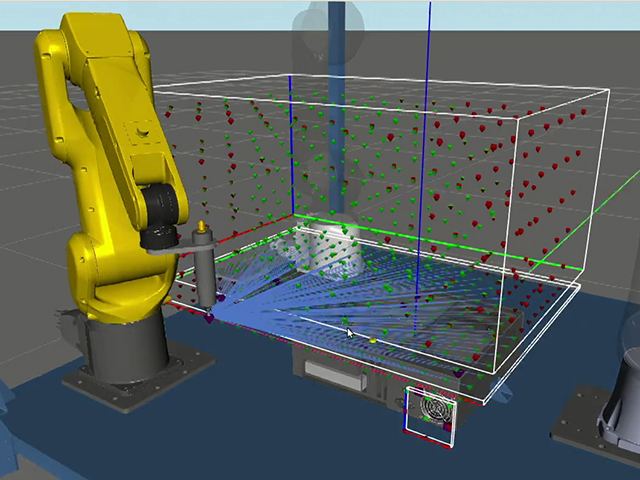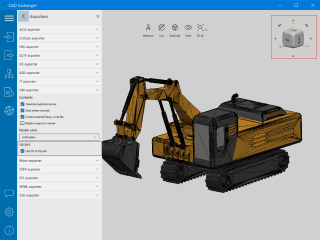

How to convert STEP
to OBJ?
Applications for end-users. SDK's and tools for software developers. Custom development services for businesses.
Trusted by industry leaders







Available in CAD Exchanger Products
 CAD Exchanger Lab
CAD Exchanger Lab
Desktop app to view, explore and convert 3D CAD data across 30+ file formats
Learn more

STEP
The STEP format is a neutral file format used for the exchange of data in the field of CAD. It can contain data, such as 3D geometry, product structure, attributes, tolerances, and materials.
Supported versions
Below you can find all the specific types of STEP files that CAD Exchanger supports:
AP203 focuses on mechanical design. It is used to exchange 3D models and associated information for product design and manufacturing processes.
Also known as the Automotive Design Standards, AP214 is used in the automotive industry. It includes additional features to represent complex assemblies and automotive-specific information.
AP242 is an advanced STEP version that supports the exchange of product information throughout the product lifecycle, including manufacturing, assembly, and maintenance.
Support of STEP in CAD Exchanger
During import and export, CAD Exchanger supports:
- B-Rep and polygonal representations;
- assembly structure, including via external files;
- names;
- user-defined and validation properties;
- PMI;
- colors;
- layers.
Follow this link to check out all the CAD Exchanger products.
Pros of the format
Interoperability
Since STEP is a neutral file format, it is not tied to any specific CAD software vendor. Almost any software that works with CAD data, and many programs that work with 3D data, can read or write this format.
Geometry and Data Preservation
STEP files are capable of representing complex 3D geometry, including curves, surfaces, and solids. They also store additional information, such as product structure, attributes, and metadata. This ensures that the integrity of the design is maintained during the exchange process, reducing the risk of data loss or conversion errors.
Long-Term Archiving
STEP files are widely recognized as a stable and reliable format for long-term data archiving. Their standardization ensures that the files will remain accessible and usable in the future.
Cons of the format
File Size
Due to their comprehensive nature, STEP files tend to contain a large amount of data, resulting in larger file sizes compared to other file formats. This can pose challenges when it comes to storage, sharing, and transferring files, particularly in cases where limited storage space or bandwidth is a concern.
The larger file sizes can also impact processing and loading times, especially when dealing with complex assemblies or intricate geometries. It may take longer to open, potentially affecting productivity.
Text-based format
The majority of STEP files are written as text files. While it allows for human readability and easy interpretation, it can introduce potential round-off errors in numerical values. These rounding errors may be negligible in most cases, but they can accumulate and impact the accuracy of the model, especially in situations where high precision is crucial.P
FAQ
What is the advantage of using STEP files?
STEP files offer interoperability, preserve geometry and associated data, are platform-independent, and are suitable for long-term archiving.
How to open a STEP file?
To open this file, you will need a compatible software application, for example, CAD Exchanger Lab. Launch the software and navigate to the 'New file' option. Browse your computer's directories and locate the STEP file you want to open. Then select the file and click "Open". Once the import process is complete, the file should be loaded into the software, allowing you to view and interact with the 3D model and associated data.
Are STEP files compatible with different CAD software?
Yes, STEP files are widely supported by various CAD software applications. They are designed to facilitate interoperability between different programs. See the full list in the 'STEP format is supported by' section.
History of STEP format
The history of this format dates back to the late 1970s when the need for a standardized method of exchanging product data between various CAD systems became apparent. To address this challenge, the International Organization for Standardization formed a committee, ISO TC 184/SC 4, dedicated to developing a universal format.
After years of collaborative effort from experts and industry stakeholders, the first version of the STEP standard, known as AP203, was released in 1994. It aimed to enable the exchange of data for mechanical and electrical designs. Over time, additional versions of the STEP standard were introduced, such as AP214 for automotive design and AP242 for complete product lifecycle information. These versions expanded the capabilities of STEP, accommodating various industry requirements and advancements in technology.
Today, the STEP file format is widely adopted and recognized as a reliable means of exchanging 3D models and associated data between different CAD systems. It has streamlined collaboration, enhanced interoperability, and improved efficiency across industries like automotive, aerospace, and manufacturing.
OBJ
The OBJ format is a popular and widely used file format for representing 3D geometry. It was initially developed by Wavefront Technologies for their Advanced Visualizer software. OBJ files store information about the vertices, faces, texture coordinates, normals, and material properties of a 3D model.
This format supports the representation of polygonal geometry, making it versatile for a wide range of applications. OBJ files are widely supported by various 3D modeling, animation, and rendering software, making it easy to share and exchange 3D models across different platforms and workflows.
Support of OBJ files in CAD Exchanger
CAD Exchanger can import files with external .mtl (material library) files, files with both multiple and single parts, and export files. Such support includes:
- polygonal representations;
- colors, materials, textures.
Follow this link to check out all the CAD Exchanger products.
Pros of the format
Universality
One of the key advantages of this format is its widespread compatibility. OBJ files can be imported and exported by a vast number of 3D modeling, animation, and rendering software applications. This broad support allows for seamless collaboration between different software packages, making it easier to share 3D models across various platforms and workflows. Whether you're working with industry-standard software or niche tools, chances are high that they will support the OBJ format.
Simplicity
The OBJ format is known for its simplicity and ease of use. OBJ files are plain text files, making them human-readable and easily editable. This simplicity makes it straightforward to manually modify or create OBJ files using a basic text editor if needed. Additionally, the file structure of OBJ is relatively straightforward, consisting of vertices, faces, and associated information. This simplicity makes it accessible for beginners and allows for quick understanding and integration with other software pipelines.
Cons of the format
Limited Geometry Support
This format has some limitations when it comes to representing complex geometry. OBJ is actually a polygonal format, so B-Rep is not supported as a class, neither for a simple cylinder nor for super-complex geometry. As a result, OBJ is not suitable when there is a need for B-Rep, and not polygonal meshes. This can be a disadvantage when working with models that require precise curved surfaces or complex mathematical representations.
Lack of Animation and Rigging Data
Another drawback of the OBJ format is that it does not inherently support animation or rigging data. OBJ files primarily focus on static 3D geometry representation and lack the ability to store information related to skeletal animation, rigging, and dynamic simulations. It also lacks several features like support for lights, LOD settings, and advanced materials. This makes it less suitable for complex animated scenes or character animations that require bone structures, joint deformations, or motion data.
FAQ
Is OBJ format specification publicly available?
Yes, it is. The OBJ file format specification defines the structure and organization of OBJ files. OBJ files begin with a list of vertex data, which consists of coordinates (X, Y, Z) that define the geometry of the 3D model. Texture coordinates (U, V) can also be included to map textures onto the model's surfaces. Normal vectors (X, Y, Z) define the orientation of the surfaces.
Faces are defined using indices that reference the previously defined vertices, texture coordinates, and normals. Groups and smoothing can be specified to organize the model's faces and define the shading and smoothness of adjacent faces. Additionally, OBJ files can reference material libraries (MTL files) that define properties like color, reflection, and transparency for the model's surfaces.
What are the typical .obj file extensions?
The OBJ file format is usually associated with two file extensions: .obj and .mtl.
.obj is the primary extension for OBJ files. It represents the 3D geometry data, including vertex coordinates, texture coordinates, normal vectors, and face definitions. The .obj file contains the essential information required to represent the shape and structure of the 3D model.
.mtl is a companion file to the OBJ format. It contains information about the material properties applied to the surfaces of the 3D model, such as color, reflectivity, transparency, and textures. The .mtl file is referenced by the OBJ file to assign materials to different parts of the model.
How to open a .obj file?
To open this file, you will need a compatible software application, for example, CAD Exchanger Lab. Launch the software and navigate to the 'New file' option. Browse your computer's directories and locate the .obj file you want to open. Then select it and click "Open". Once the import process is complete, the .obj file should be loaded into the software, allowing you to view and interact with the 3D model and associated data.
History of the OBJ format
The OBJ file format has a rich history in the field of computer graphics. It was originally developed by Wavefront Technologies, a company known for its pioneering work in 3D computer graphics and animation software. The OBJ format was first introduced in the late 1980s as part of Wavefront's Advanced Visualizer software, which was widely used in the film and entertainment industry.
Wavefront designed the OBJ format to provide a standard way to exchange 3D models between different software applications. It aimed to address the interoperability challenges that arose due to the diverse range of 3D modeling and animation software available at the time.
As the OBJ format gained popularity, it became widely adopted by the computer graphics community. Its simplicity, versatility, and support for geometry, texture, and material data made it a favored choice for sharing 3D models across various platforms and software packages.
The OBJ format has been embraced by numerous 3D software applications, making it a de facto standard for exchanging 3D models. Despite the emergence of newer formats, OBJ remains widely used and supported due to its long-standing history, compatibility, and ease of integration into different workflows. Today, the OBJ format continues to play a significant role in the world of 3D computer graphics.
Convert STEP
to OBJ
Need to work with CAD files in numerous formats? No worries.
From STEP to OBJ, CAD Exchanger gets you covered.
What Our Delighted Customers Say
From Our Blog

Everything you need to know about CAD file formats
A CAD file is an output of a CAD software, containing key information about the designed object: its geometry and topology representation, 3D model hierarchy, metadata, and visual attributes depending on the format of the file.
Read more
Realtime Robotics enhances responsive workcell monitoring by reading CAD files with CAD Exchanger
CAD Exchanger enables RapidSense and RapidPlan to read 3D CAD formats thanks to a unified API, fast data processing, adjustable meshing, and cancellation support.
Read more
3D XML and Solid Edge, broader versions coverage for CATIA, JT, Parasolid, and SOLIDWORKS mesh colors in CAD Exchanger GUI 3.10
Two new native formats and more possibilities in reading and writing CATIA, JT, Parasolid, SOLIDWORKS, Collada, FBX, GLTF, OBJ, and STEP.
Read more